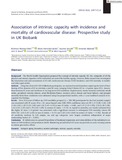Mostrar el registro sencillo del ítem
Association of intrinsic capacity with incidence and mortality of cardiovascular disease: prospective study in UK Biobank
| dc.creator | Ramírez Vélez, Robinson | es_ES |
| dc.creator | Iriarte-Fernández, María | es_ES |
| dc.creator | Santafé Rodrigo, Guzmán | es_ES |
| dc.creator | Malanda Trigueros, Armando | es_ES |
| dc.creator | Beard, John R. | es_ES |
| dc.creator | García Hermoso, Antonio | es_ES |
| dc.creator | Izquierdo Redín, Mikel | es_ES |
| dc.date.accessioned | 2023-09-08T17:37:17Z | |
| dc.date.available | 2023-09-08T17:37:17Z | |
| dc.date.issued | 2023 | |
| dc.identifier.citation | Ramírez-Vélez, R., Iriarte-Fernández, M., Santafé, G., Malanda, A., Beard, J. R., Garcia-Hermoso, A., Izquierdo, M. (2023) Association of intrinsic capacity with incidence and mortality of cardiovascular disease: prospective study in UK Biobank. Journal of Cachexia, Sarcopenia and Muscle (JCSM), 1-10. https://doi.org/10.1002/jcsm.13283. | en |
| dc.identifier.issn | 2190-5991 | |
| dc.identifier.uri | https://hdl.handle.net/2454/46255 | |
| dc.description.abstract | Background: The World Health Organization proposed the concept of intrinsic capacity (IC; the composite of all the physical and mental capacities of the individual) as central for healthy ageing. However, little research has investigated the interaction and joint associations of IC with cardiovascular disease (CVD) incidence and CVD mortality in middle- and older-aged adults. Methods: Using data from 443 130 UK Biobank participants, we analysed seven biomarkers capturing the level of functioning of five domains of IC to calculate a total IC score (ranging from 0 [better IC] to +4 points [poor IC]). Associations between IC score and incidence of six long-term CVD conditions (hypertension, stroke/transient ischaemic attack stroke, peripheral vascular disease, atrial fibrillation/flutter, coronary artery disease and heart failure), and grouped mortality from these conditions were estimated using Cox proportional models, with a 1-year landmark analysis to triangulate the findings. Results: Over 10.6 years of follow-up, CVD morbidity grouped (n = 384 380 participants for the final analytic sample) was associated with IC scores (0 to +4): mean hazard ratio (HR) [95% confidence interval, CI] 1.11 [1.08–1.14], 1.20 [1.16–1.24], 1.29 [1.23–1.36] and 1.56 [1.45–1.59] in men (C-index = 0.68), and 1.17 [1.13–1.20], 1.30 [1.26–1.36], 1.52 [1.45–1.59] and 1.78 [1.67–1.89] in women (C-index = 0.70). In regard to mortality, our results indicated that the higher IC score (+4 points) was associated with a significant increase in subsequent CVD mortality (mean HR [95% CI]: 2.10 [1.81–2.43] in men [C-index = 0.75] and 2.29 [1.85–2.84] in women [C-index = 0.78]). Results of all sensitivity analyses by full sample, sex and age categories were largely consistent independent of major confounding factors (P < 0.001). Conclusions: IC deficit score is a powerful predictor of functional trajectories and vulnerabilities of the individual in relation to CVD incidence and premature death. Monitoring an individual's IC score may provide an early-warning system to initiate preventive efforts. | en |
| dc.description.sponsorship | This study was funded by Universidad Pública de Navarra. | en |
| dc.format.mimetype | application/pdf | en |
| dc.language.iso | eng | en |
| dc.publisher | Wiley | en |
| dc.relation.ispartof | Journal of Cachexia, Sarcopenia and Muscle (2023) | en |
| dc.rights | © 2023 The Authors. This is an open access article under the terms of the Creative Commons Attribution-NonCommercial License, which permits use, distribution and reproduction in any medium, provided the original work is properly cited and is not used for commercial purposes. | en |
| dc.rights.uri | http://creativecommons.org/licenses/by-nc/4.0/ | |
| dc.subject | Biological ageing | en |
| dc.subject | Biomarkers | en |
| dc.subject | Incident pathologies | en |
| dc.subject | Intrinsic capacity | en |
| dc.subject | Mortality | en |
| dc.title | Association of intrinsic capacity with incidence and mortality of cardiovascular disease: prospective study in UK Biobank | en |
| dc.type | Artículo / Artikulua | es |
| dc.type | info:eu-repo/semantics/article | en |
| dc.date.updated | 2023-09-08T17:17:26Z | |
| dc.contributor.department | Ciencias de la Salud | es_ES |
| dc.contributor.department | Osasun Zientziak | eu |
| dc.contributor.department | Estadística, Informática y Matemáticas | es_ES |
| dc.contributor.department | Estatistika, Informatika eta Matematika | eu |
| dc.contributor.department | Ingeniería Eléctrica, Electrónica y de Comunicación | es_ES |
| dc.contributor.department | Ingeniaritza Elektrikoa, Elektronikoa eta Telekomunikazio Ingeniaritza | eu |
| dc.contributor.department | Institute for Advanced Materials and Mathematics - INAMAT2 | en |
| dc.rights.accessRights | Acceso abierto / Sarbide irekia | es |
| dc.rights.accessRights | info:eu-repo/semantics/openAccess | en |
| dc.identifier.doi | 10.1002/jcsm.13283 | |
| dc.relation.publisherversion | https://doi.org/10.1002/jcsm.13283 | |
| dc.type.version | Versión publicada / Argitaratu den bertsioa | es |
| dc.type.version | info:eu-repo/semantics/publishedVersion | en |
| dc.contributor.funder | Universidad Pública de Navarra / Nafarroako Unibertsitate Publikoa | es |
Ficheros en el ítem
Este ítem aparece en la(s) siguiente(s) colección(ones)
La licencia del ítem se describe como © 2023 The Authors. This is an open access article under the terms of the Creative Commons Attribution-NonCommercial License, which permits use, distribution and reproduction in any medium, provided the original work is properly cited and is not used for commercial purposes.




